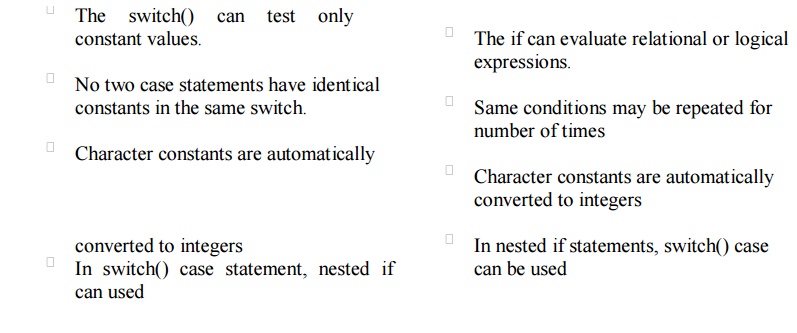Chapter: Programming and Data Structures
Important Short Questions and Answers: Programming Fundamentals
1. Define global declaration?
The variables that are
used in more than one function throughout the program are called global
variables and declared in outside of all the function that is before the main()
function.
2. Define data types?
Data type is the type of data, that are going to access within the program. „C‟ supports different data types

3.Define variable with example?
A variable is an
identifier and it may take different values at different times of during the
execution .
A variable name can be
any combinations of 1 to 8 alphabets, digits or underscore. Example:
int
a,b;
here a,b are variables
4. What is decision making statement?
Decision making
statement is used to break the normal flow of the program and execute part of
the statement based on some condition.
5.What are the various decision making
statements available in C ?
If statement
if…else statement
nested if statement
if…else ladder statement
switch statement
6. Distinguish between Call by value Call by
reference.

7.
What is an array?
An array is a collection of data of same
data type. the elements of the array are stored in continuous memory location
and array elements are processing using its index.
Example:
int a[10];
Here‟is
an„aarray name.
8.
What is two dimensional array?
Two dimensional is an array of one
dimensional array. The elements in the array are referenced with help of its
row and column index.
Example:
Int
a[2][2];
9.
Define is function?
Function are group of statements that
can be perform a task. Function reduce the amount of coding and the function
can be called from another program.
Example:
main()
{ fun()
------- {
fun(); -------
-------- }
}
10.What
are the various
looping statements available in ‘C’?
While statement
Do….while
statement
For statement
11.
What are the uses of Pointers?
Pointers are used to return more than one value to
the function
Pointers are more efficient in handling the data in
arrays
Pointers reduce the length and complexity of the
program
They increase the execution speed
The pointers save data storage space in memory
12.What is a Pointer? How a variable is
declared to the pointer?
Pointer is a
variable which holds the address of another variable.
Pointer
Declaration: datatype *variable-name;
Example: int
*x, c=5; x=&a;
13.What is the difference between if and
while statement?
If
It is a conditional statement
If the condition is true, it executes some
statements.
If the condition is false then it stops the
execution the statements
While
It is a loop control statement
Executes the statements within the while block if
the condition is true.
If the condition is false the control is transferred
to the next statement of the loop.
14. Define pre-processor in C.
Preprocessor are used to link the library files in
to source program, that are placed before the main() function and it have three
preprocessor directives that are
Macro inclusion
Conditional inclusion
File inclusion
15. Define recursive function?
A function is a set of
instructions used to perform a specified task which repeatedly occurs in the
main program. If a function calls itself again and again , hten that function
is called recursive function.
16.
What is
the difference between
while and
The while is an entry
controlled statement. The statement inside the while may not be executed at all
when the condition becomes false at the first attempt itself.
The do …while is an exit controlled statement. The statements in the block are executed at least once.
17. Define Operator with example?
An operator is a symbol
that specifies an operation to be performed on operands . some operators
require two operands called binary operators, while other acts upon only one
operand called unary operator.
Example: a+b here a,b are operands and + is operator
18. Define conditional operator or
ternary operator?
Conditional operator
itself checks the condition and execute the statement depending on the
condition. (a>b)?a:b if a is greater than b means the a value will be return
otherwise b value will be return.
Example: big=a>b?a:b;
19. Compare of switch() case and nested
if statement

20. What are steps involved in looping
statements?
Initialization of a condition variable.
Test the control statement.
Executing the body of the loop depending on the
condition.
Updating the condition variable.
20.
Define break statement?
the break statements is
used terminate the loop. When the break statement is encountered inside a loop,
the loop is immediately exited and the program continues with the statement
immediately following the loop.
Example: while(condition)
{
…………
If(condition)
break;
………
}
22.
Define null pointer?
A pointer is said to be
a null pointer when its right value is 0, a null pointer can never point to a
valid data. For checking a pointer, if it is assigned to 0, then it is a null
pointer and is not valid
Example:
int *a; int *b; a=b=0
;
Related Topics